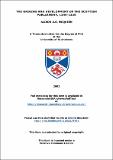Files in this item
The origins and development of the Scottish Parliament, 1249-1329
Item metadata
| dc.contributor.advisor | Brown, Michael Hunter | |
| dc.contributor.author | McQueen, Alison A.B. | |
| dc.coverage.spatial | 350 | en_US |
| dc.date.accessioned | 2015-04-09T15:14:44Z | |
| dc.date.available | 2015-04-09T15:14:44Z | |
| dc.date.issued | 2002-11 | |
| dc.identifier | uk.bl.ethos.546838 | |
| dc.identifier.uri | https://hdl.handle.net/10023/6461 | |
| dc.description.abstract | This thesis examines the origins and development of Scottish parliaments between 1124 and 1329. Previous historians have judged that parliaments formed no place within Scotland before 1290 and no frequent roIe until the reign of Robert I. By examining the membership, business and frequency of early governmental bodies, a more thorough portrayal of their growth has been constructed. Chapter 1 directly compares the minority governments for Alexander III, and for Lady Margaret and the guardianship. This highlights the influence of the absence of an adult king over developing parliaments, countering the portrayal of actual parliaments held extensively during Alexander Ill's minority while showing how the guardians defined their institution due to a closer relationship with England. Chapter 2 examines English influences on the Scottish parliament, from Henry III' s involvement as father-in-law of Alexander III, to Edward I's overlordship between 1296 and 1306. Chapter 3 examines the role of parliament under John, showing the frequent meetings used to re-establish the kingship and resist Edward I's encroachment. Chapter 4 looks at the sporadic use of parliaments during the second guardianship, and how they were employed to counter the English administration and maintain Scottish authority. Chapters 5, 6 and 7 look at the reign of Robert I, who made parliaments an essential part of government, held with increasing frequency, expanded business and a more defined membership. In conclusion, there is significant evidence to show that parliaments not only developed across this period, but also held an important role within government and national identity well before the reign of Robert 1. This was where the king took consent and support for his policies, issued judgements or rewarded supporters, and where the community gathered during the absence of an adult monarch to maintain unity and political cohesion. | en_US |
| dc.language.iso | en | en_US |
| dc.publisher | University of St Andrews | |
| dc.rights | Creative Commons Attribution-NonCommercial-NoDerivatives 4.0 International | |
| dc.rights.uri | http://creativecommons.org/licenses/by-nc-nd/4.0/ | |
| dc.subject.lcc | DA783.2M8 | |
| dc.title | The origins and development of the Scottish Parliament, 1249-1329 | en_US |
| dc.type | Thesis | en_US |
| dc.type.qualificationlevel | Doctoral | en_US |
| dc.type.qualificationname | PhD Doctor of Philosophy | en_US |
| dc.publisher.institution | The University of St Andrews | en_US |
This item appears in the following Collection(s)
Except where otherwise noted within the work, this item's licence for re-use is described as Creative Commons Attribution-NonCommercial-NoDerivatives 4.0 International
Items in the St Andrews Research Repository are protected by copyright, with all rights reserved, unless otherwise indicated.


